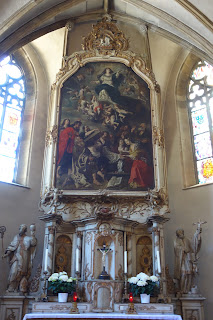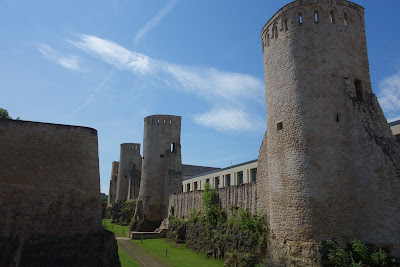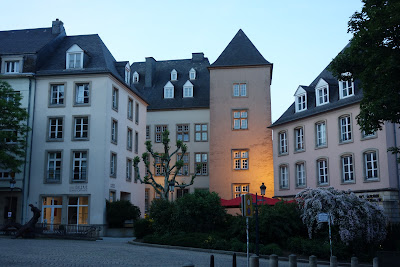We approached Luxembourg from the north and had just enough time to make a stop at the nicely restored Vianden Castle which sits on a hilltop just north of Luxembourg city. Romanesque in design with Gothic trimmings, this 11th century castle is exquisitely beautiful. The interior of the castle is minimally refurbished, so there's not much to the self-guided tour which Bob and I hurried through before closing. But it was definitely worth the effort to get there.
Luxembourg is one of the smallest countries in the world, encompassing only 998 square miles. It is one of the wealthiest nations in the world with a healthy economy and high GDP (gross national product per capita) It's city's old quarters and fortifications are designated as another UNESCO World Heritage Site. Our plan was to stay two nights near the old quarters and tour it's treasure trove of sites the next day and a half until we would drive to Frankfort and board a plane back to Texas. Driving into the small country, I was charmed by the colorful homes which lined the streets of most towns. Nearing the city, it was quickly apparent that this was a very modern progressive city, although we did not spend time exploring that side of it's nature.
We woke up the morning of May 17 to go sip on a cup of hot chocolate while watching the changing of the guards at Palais Grand-Ducal, the official residence of the Grand Duke and royal family of Luxembourg. Yummmmmm . . . so many flavors!
We passed by St. Michael's church, where the first church in Luxembourg was built in 987 as the castle chapel for the Count of Luxembourg. The present structure was built in the 16th century.
Our plan for the day was to complete the "Wenzel Circular Walk", which is an outstanding cultural and historical guide to the city. We began at the top of the "Bock", or rocky ledge where a castle once stood. Notice the remains of the castle. A road now runs across the red arched "castle gate" and through what would have been the middle of the castle. The current castle gate replaced a wooden drawbridge that was used until 1735.
From here we can see the Alzette river running through "The Grund", which is one of the oldest and authentic neighborhoods in Luxembourg.


From the "backside" of the castle, we could see the juxtaposition of old and new Luxembourg City. Passerelle Viaduc is one of the most historically significant bridges in Luxembourg and was completed in 1861 by a British company. This bridge can be seen in the "Grund" and other parts of the city as well.
Below the "castle", within the "bock" are the famous "Casemates" - a network of 40,000 square meters of passages and rooms carved from solid rock and date back to Spanish rule in 1644. These were used for sheltering thousands of defenders, as well as equipment, horses, workshops, kitchens, and slaughterhouses. Bob and I took a tour of these later that day. Great views of the "Grund" can be seen from openings in the casements. Below are photos of the Casemates from outside and then from inside.
However, it is the views from The Walls of Corniche that make it so special.
From the walkway we could see The Gate of Grund, which dates back to 1632. The path descends lower in the valley and across a small footbridge which leads to another fortified wall and Jacob's tower across the valley.
From there, we were led to Rham Plateau, where we saw additional towers and walled fortifications - and a nice place to take a break!
The pathway then led around the valley and across parts of the third walls of the city. We saw what is called "The Holy Ghost" Plateau where in the upper part of the city a 13th century cloister of nuns was located. In the 1600's a fortress and barracks were built there.
We descended down into the "Grund" and walked along the river. Some of the most beautiful views of the city are seen from this vantage point.
Walking further along the river, we neared Neumünster Abbey. The tall steeple in the complex of buildings makes it easily recognizable. Where we were walking, just across the river from the Abbey sits a notable purple statue, which seems completely out of place. We learned that the "Melusina Mermaid" is the symbol of Luxembourg and her legend is a big part of their history. I did find a "Melusina" silver charm in memory of this visit!
The Legend of Melusina
One day, Count Siegfried was walking on the banks of the Alzette when he met a princess more beautiful than the day. This gorgeous creature was the nymph of the Alzette, named Melusina, and charmed the valley. Siegfried fell headlong in love with her and in no time had offered his heart and crown to the young woman, who accepted. Melusina, however, made one condition, which Siegfried had to promise to observe or lose her forever. On Saturdays, the count was to leave Melusina alone in her room and neither see her nor attempt to find out what she was doing. Siegfried agreed and the couple married.
For years, they lived happily and had many children. One Saturday, however Siegfried walked past Melusina’s room and, hearing a noise, looked through the keyhole. Imagine his horror when he saw her splashing about in a large pool, her body ending in a fish tail. Now that her true nature had been revealed, Melusina uttered a piercing cry and was swallowed up by the earth. Since then, the nymph of the Alzette has been sealed in a rock known as the Bock and only reappears once every seven years.
After a full day in the old city, we found an elevator which took us to upper town and from there we worked our way toward a newer part of the city.
We found a lively city square where we enjoyed dinner while listening to live music, watching people dance, and simply relaxing. What a perfect end to a perfect day!
I told Bob, I thought I could enjoy living in Luxembourg. He just laughed. Fortunately, . . . Luxembourg will live in me . . .




























































































































No comments:
Post a Comment